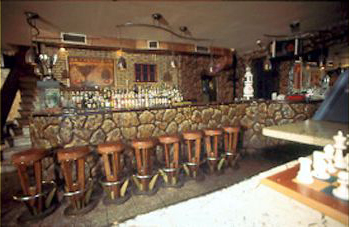|
|
 |
History

zoom
Christian monasticism is the removal of humans from the organized society and the voluntary restriction in places where they can experience the religious values in a very particular way.
According to the evangelic (Matthew. 19, 5-6, Efes. 5,32 Heb. 13,4 etc.) and patristic teaching (PG 29, 160.30, 745.8, 1185.37, 316 etc.), marriage is a divine institution, a saint task and a “great mystery "; however, celibacy for God is morally superior (A Corinth. 7,38 etc…), since it constitutes fulfillment of God’s advice and not of His command and particularly since this sacrifice serves man’s soul, his most valuable good. Consequently, Christian monastic life is neither a product of effect of Eastern religions, as many have argued, neither the result of the reaction of conservative believers after the looseness brought in customs by the contact of Christianity with iconolatry, as others believe, nor a result of fear of Christians against the tremendous persecutions of Romans.
It was created because of other reasons of more spiritual meaning. Since the Christian religion accentuated monasticism as “an ideal life for believers", kind and noble souls exchanged the crowded secular centers for deserted places, where in absolute calm and peacefulness, away from corruption and the world’s havoc, away from lies and delusions, they uninterruptedly worshipped God and forged their faith in HIM.
This Christian monasticism was first met in Egypt, approximately at the end of the 3rd or the beginning of the 4th century. Even thought the first known hermit is Paul the Theban, St Antony the Great (251-357) is considered as the founder of monastic life. Son of an aristocratic and rich family, he lived hermetic in the desert for more than seventy years. There, he worked and worshipped God with fasts, vigils and prayers. His fame, according to his biographer St. Athanasios the Great, excited the interest of many devout people, who visited him, listened to his teaching, became his students and stayed in the desert with him. There, in huts they used to build in great distances between them, they followed the example of the teacher of the hermitic life. This hermetic form of monastic life was changed by one of St. Antony the Great students, Pahomios (290-346), who more or less founded ten monasteries in the desert of Thebes and established the coenobitic system of life. Soon, three known monks imitated him: Ammonios the Parotis (fourth century) and Pamvo the Blessed (fourth century.) in the desert of Nitria and Makarios the Egyptian (300-390) in the Skete of Lower Egypt. The aforementioned hermits and their numerous students lived separately in different cells. Only on Sundays and during feasts they met for common prayer. Their life therefore presented a coenobitic character.
From the aforementioned Egyptian hermetic centers, monasticism was spread, in its three forms, through the peninsula of Sinai, where, few years later, great ascetics appeared. Among them, very important personalities of asceticism are Nile of Sinai (5th century), son of the homonymous hermit of Asia Minor and Ioannis of Sinai (525-600), who is the writer of the eminent book "Paradise Scale", which was particularly loved and read by monks.
At about the half of the 4th century, Ilarion of Gaza introduces the monastic life in Palestine (371).
At the same period, monasticism develops in Mesopotamia, Syria and Asia Minor. Jacob (338) of Nisei (Mesopotamia) founded, along with others, monasteries all around his birthplace, after the destruction of which, monastic life was transferred to Edessa, where the eminent Ephraim of Syros (305-373) prospered. Near Antiochus of Syria, many and greatly known monks such as Simeon the Stylite (459) and others lived during that period and later. Since about the half of the 4th century, monastic life had also been introduced in Asia Minor from Egypt. Among those who were singled out then was the hermit Nile (360-430) and Markus the Hermit (380-430), Reverent Fathers of different monasteries near Ankara. At the same period, Vasilios the Great (330-378) systematized monasticism and gave it a social character. Also, special contribution in the development of monasticism was paid by two great men from Kappadokia, Gregorios the Nanzéanzinos (328-390) and Gregorios of Nissis (335-395), who contributed a lot with their great work.
Meanwhile, Palestine became a very interesting place for monks because it was there were Christ was born, acted and died. Among the most important monastic personalities of that period are Theodosios the Cenobite (414-519), who founded the first Lavra in Jerusalem and Savvas (432-532), who overall founded seven monasteries in Palestine. From Asia Minor, where great ascetic centers were founded (mountain Olympus of Bithynia, mountain Latros and others), monastic life was extended to Vasilevousa.
There, several and great monasteries were founded such as for example the monastery of Stoudio, the monastery of Akimiton and others, who were helped by the devout devotion of many Byzantine emperors and other tycoons to the ideal of monasticism and their voluminous economic assistance towards this divine institution.
The Athos peninsula, as a deserted place, had already become (5th century.) a shelter for devout people, who full of bitterness and disappointed by the filthiness of the everyday social life of their era, walked up there in order to visit the “inner man" and then, through this experience, to worship God in a better way.
In the beginning, the life of monks on Athos presented an isolated and particularly cavernous form. Since the period of iconoclasm, the communal system was developed, after the arrival to Athos of Athanasios, a monk from Trapezounda (10th century.) and the foundation of Great Lavra with expenses paid by the emperors. The coenobitic system of life was thereon established in all monasteries founded there. This system was thereon followed by the monks of Athos with only occasional interruptions and of different duration for each monastery, when, as it is known, national problems imposed the idiorrhythmic way of life.
The organized monasticism of Athos during its one thousand years of life has presented periods of acne and periods of ordeal. Én both cases, the Athos peninsula constituted a field of intellectual struggles, where monks lived with continuous prayer and simultaneous cultivation of virtue and knowledge.
Thus, the Athos peninsula gradually became a radiation center for the orthodox monastic life and the Greek wisdom. The monasticism of Athos resembles of course the Egyptian hermitic life, the Asiatic asceticism and the western social monasticism, but at the same time differs from all those, because it has its own unique character. Behind the severity of its regulations, you can find the tradition of the Greek soul that distinguishes for its hospitality, its continuous effort and its sacrifice. Every year, thousands of visitors stay in Agion Oros free of charge. The numerous prayers of the monks refer not only to their own salvation, but also to the salvation of all people. Placed beyond and above nature, the greatness of which does not touch and fascinate them - they have surrendered to deep reflection, with the seal of pain and deterioration obvious on their faces, they have only internal visions and hear only their own internal cries, cries regarding an immeasurable desire for personal penitence and penitence of the world.
Today, the Monastic State of Athos reveals the resistless impetus of humans towards the eternal God and symbolizes the dogmatic and moral unity of all orthodox believers. Because of their spiritually, the mountain was named Agion (Sacred). If ancient Greeks considered Olympus as the residence of Gods and if the chosen people of God regarded Sinai as the place from where God would descend to earth, the orthodox believers consider Athos as the place from where people ascend to God, a place of divine approach.
This holy land is concisely presented through the lines and photographs that follow. The anthropographic review of the Athos peninsula comes first and then follows a chronological diagram of the main events and points of this “state” of monks, as well as a short historical outline of the region divided in periods. Tours in various institutions of Mount Athos follow. The monasteries come first and then the hermits and all the other monastic residences. Moreover, an overall review of the artifacts of Christian Art found in Agion Oros is presented. The monuments of conjectural arts are presented, followed by the works of decorative art. In conclusion, there is the addition of a paragraph with the subject of “time course" in the country of calmness and the presentation is concluded with the quotation of chosen relative bibliography.
If for the presentation of a single monastery or skete a bulky volume is required, it is easy for someone to understand the limits of this small report that refers to the State of Athos as a total. For the partial completion of these voids, footnotes and general bibliography have been added, something that as we all know, is very unusual for similar projects. Consequently, anyone who wishes for further study and research on the aforementioned subjects that are basically covered only in terms of bibliography can resort to the relative studies indicated by the footnotes and the chosen bibliography.
In order for the visitor to understand the peculiarity of the life of the monks of Athos, it is not necessary for him to read several relatively books or to be accompanied by a good guide. If someone approaches the Holy mountain without prejudice and hastiness, if he has the same faith and devotion as the heart of a humble pilgrim in the medieval era, if he stays with the monks during their vigils, their messes, their litanies, their work -time and any other event and if, finally, he listens to them talking with their precious experience and wisdom, then he will certainly understand why their life from afar seems strange and peculiar, hard and away from the world but from closer blessed and saintly.
|





